AP HuG - FINAL EXAM!!!
0.0(0)
0.0(0)
Card Sorting
1/118
Earn XP
Study Analytics
Name | Mastery | Learn | Test | Matching | Spaced |
|---|
No study sessions yet.
119 Terms
1
New cards
Scale
C1K1 Relationship between places studied and Earth.
2
New cards
Cartography
C1K1 The science of map making.
3
New cards
Remote sensing
Acquisition of data from a long distance.
RS: gets data -> GIS: houses data -> GPS: applies data.
RS: gets data -> GIS: houses data -> GPS: applies data.
4
New cards
GPS
C1K1 System that finds the precise location of something on Earth.
5
New cards
GIS
(C1K1) Data analysis thru satellites. Maps combine objects to create images -> LAYERED
6
New cards
Site
(C1K2) Physical feature of place. Influences settlements.
7
New cards
Situation
(C1K2) Location of a place relative to other places.
8
New cards
Cultural landscape
(C1K2, Ch. 4) Creation of human culture opposite the natural landscape.
9
New cards
Arithmetic density
(C2K1) # of objects in an area (people over land area.)
10
New cards
Physiological density
(C2K1) # of people supported by a unit of arable land (people over arable land).
11
New cards
Agricultural Density
(C2K1) Ratio of farmers to amount of arable land (farmers over arable land)
12
New cards
Diffusion
C1K3 Culture that expands over a long distance.
13
New cards
Relocation Diffusion
C1K3 The spread of an idea through physical movement of people.
14
New cards
Expansion Diffusion
C1K3 The spread of culture from one place to another. UMBRELLA TERM!
15
New cards
Contagious Diffusion
C1K3 Culture spreads like a disease; no higher power needed.
16
New cards
Hierarchical Diffusion
C1K3 Culture spread down from a place of high power.
17
New cards
Absolute location
An exact place on Earth, given in terms of latitude and longitude.
18
New cards
Relative location
The description of a place in relation to other places.
19
New cards
Map scale
Ratio between distance on map versus actual distance in the world.
20
New cards
Toponym
The name of a geographical place or region.
21
New cards
Space-Time Compression
C1K3 Explains how innovations diffuse info. Places become closer over time.
22
New cards
Environmental determinism
The physical environment dictates human actions. Climate can determine human efficiency i.e. better health overall, less deaths, higher standard of living.
23
New cards
Possibilism
C1K4 The physical environment may limit human actions, but humans can still alter their environments.
24
New cards
Formal region
C1K2 Area where everyone shares distinctive characteristics (e.g. political borders of U.S. states).
25
New cards
Functional region
C1K2 Area organized around focal point/node. Less important outwards (circulation around New York Times in New York (node)).
26
New cards
Vernacular region
C1K2 An area part of cultural identity, perceptual (e.g. Culver's in Wisconsin).
27
New cards
Distance decay
C1K3 Contact lessens over distance; eventually disappears.
28
New cards
Meridian
Line of longitude.
29
New cards
Parallel
Line of latitude.
30
New cards
Globalization
(C1K3) A force or process involving the entire world.
31
New cards
Spatial association
Connection between places in space.
32
New cards
Developed Country/MDC
A nation that has a high quality of life, advanced economy, and progressive infrastructure in relation to other less industrialized nations, e.g. Japan.
33
New cards
Developing Country/LDC
Low income places confronting severe structural impediments to sustainable progress, e.g. many countries in Sub-Saharan Africa are LDCs.
34
New cards
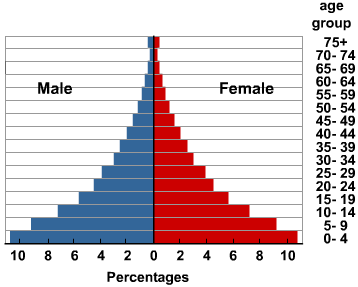
DTM Stage 1: Low Growth
(C2K2) Very high CBR, very high CDR, very low NIR.
Relied on hunting/gathering. No country like this anymore.
Relied on hunting/gathering. No country like this anymore.
35
New cards
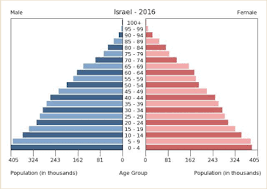
DTM Stage 2: High Growth
(C2K2) High CBR, rapidly declining CDR -> very high NIR.
Came as a result of the industrial and medical revolutions.
Came as a result of the industrial and medical revolutions.
36
New cards
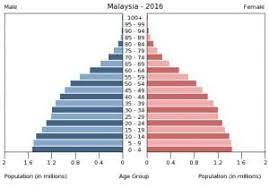
DTM Stage 3: Moderate Growth
(C2K2) Rapidly Declining CBR, moderately declining CDR -> Moderate NIR.
Result of economic changes from farm to city.
Result of economic changes from farm to city.
37
New cards
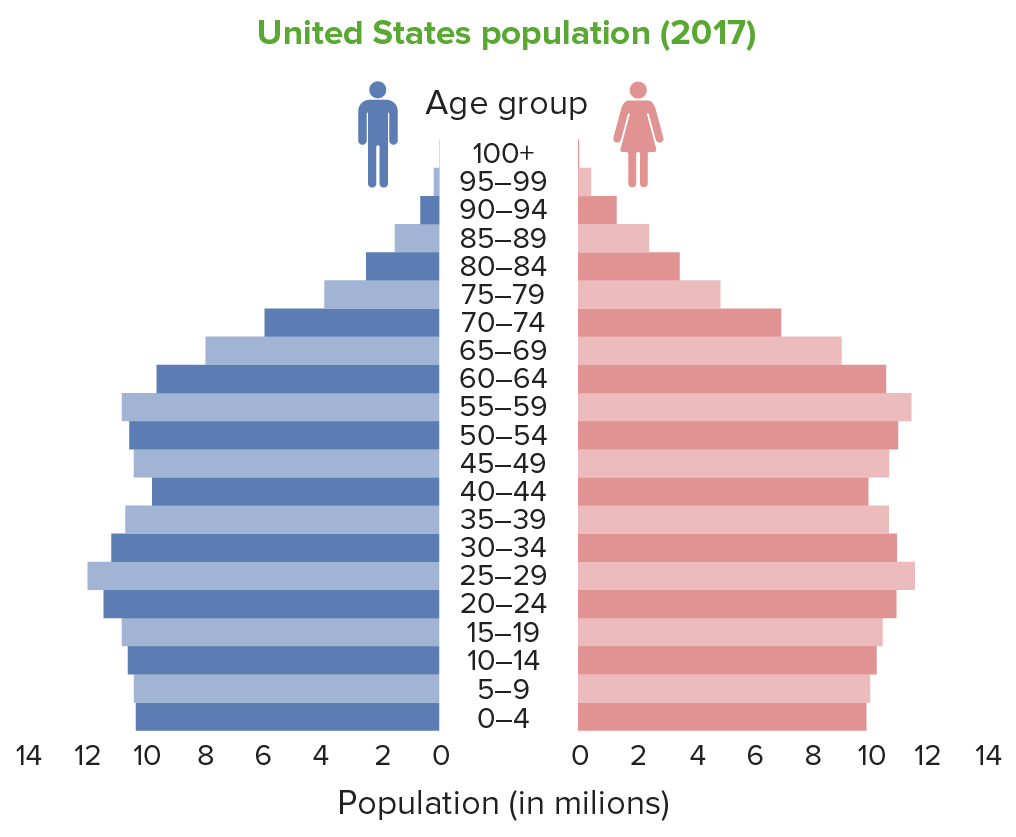
DTM Stage 4: Low Growth
(C2K2) Very low CBR
Low or slightly increasing CDR
Zero or negative NIR.
Social changes/birth control cause zero-population growth.
Differences from stage 1: Total population (Low -> High), CBR/CDR (High -> Low)
Low or slightly increasing CDR
Zero or negative NIR.
Social changes/birth control cause zero-population growth.
Differences from stage 1: Total population (Low -> High), CBR/CDR (High -> Low)
38
New cards
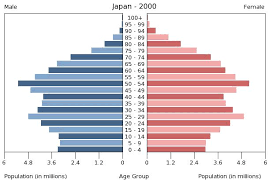
DTM Stage 5: Decline
(C2K4) Very low CBR, increasing CDR -> Declining NIR.
Very low birth rates -> relatively few young women aging into child birthing years, few choose to have kids.
39
New cards
Demographic Transition
(C2K2) Process of:
High CBR + CDR + low NIR ->
Low CBR + CDR + low NIR and a higher total population.
High CBR + CDR + low NIR ->
Low CBR + CDR + low NIR and a higher total population.
40
New cards
Dependency ratio
(C2K3) # of ppl who are too young/old to work (under 15, over 65).
41
New cards
Population clusters
(C2K1) Places where the world's amount of people is most distributed. E.g. 4 pop clusters: East Asia, South Asia, Europe, Southeast Asia.
42
New cards
Doubling time
Time it takes for a population to double.
43
New cards
Ecumene
(C2K1) The portion of Earth's surface occupied by permanent human settlement.
44
New cards
ETM
(C2K3) The process of change in the distinctive health threats in each stage of the demographic transition.
45
New cards
Infant mortality rate
Number of infant deaths for every 1,000 live births.
46
New cards
Thomas Malthus
(C2K4) Claimed population was growing faster than the food supply (pop=geometric increase, food=arithmetic increase).
Believed pop growth pushed against resources:
Moral restraint -> lower CBR (abstinence?)
Disease/famine/war -> higher CDR.
Believed pop growth pushed against resources:
Moral restraint -> lower CBR (abstinence?)
Disease/famine/war -> higher CDR.
47
New cards
Neo-Malthusians
(C2K4) People who believed in Malthusian Theory and in the idea that population was not only outstripping food but other resources.
48
New cards

Population pyramid
Displays the base of a country divided by gender.
49
New cards
Natural Increase Rate
(C2K2) % by which population grows in a year.
50
New cards
Industrial revolution
Transition from creating goods by hand to using machines. Spanned from 1760-1840.
51
New cards
CBR
(C2K2) Number of live births in a year for every 1000 people alive in a society.
52
New cards
CDR
(C2K2) The number of deaths per year per 1,000 people.
53
New cards
Forced migration
Migrant is compelled to emigrate away from their home for social/economic/environmental reasons.
54
New cards
Internal migration
Permanent move within a country.
55
New cards
International Migration
One country -> another.
56
New cards
Push factor
Forces people to move out.
57
New cards
Pull factor
Forces people to move in.
58
New cards
Refugee
Someone who is forced to move away from their country of origin due to the influence of social/political/environmental factors.
59
New cards
IDP
Someone who is influenced by social/political/environmental factors but cannot leave their country of origin.
60
New cards
Voluntary migration
The migrant chooses to migrate out of desire for new opportunities.
61
New cards
Carrying capacity
The average population size of a specific location, e.g. the carrying capacity of eastern Russia is incredibly low due to its temperature and climate.
62
New cards
Census
(C2K1) Data source for population geography. Controversial for 2 reasons: Nonparticipation and sampling.
63
New cards
Immigrant
(C3K1) Migrant to a location.
64
New cards
Emigrant
(C3K1) Migrant from a location.
65
New cards
Cyclic movement
(C3K1) Short-term, repetitive movements that recur on a regular basis. (E.g. Dorm -> home in college).
66
New cards
Baby boom
(C2NB) A unit of time that involves a drastic increase to birth rate e.g. The end of WW2 led to a baby boom as it was a time of relative peace in many countries. I.e. Population Explosion.
67
New cards
Chain migration
(C3K4) Migration b/c of relatives/people of the same nationality are already there.
68
New cards
Ravenstein's Laws: #1
Most migrants that relocate create counter-migration.
- Interregional/intraregional
- Interregional/intraregional
69
New cards
Ravenstein's Laws: #2
Most migrants relocate within their own country or short distance.
- Exceptions:
-> Women are shorter distance.
-> Men are longer distance.
-> Distance decay applies here.
- Exceptions:
-> Women are shorter distance.
-> Men are longer distance.
-> Distance decay applies here.
70
New cards
Ravenstein's Laws: #3
Most migrants relocate to large centers of economic activity.
- Rural -> Urban
-> Interregional or intraregional.
-> E.g. moving b/c parent's job.
- Rural -> Urban
-> Interregional or intraregional.
-> E.g. moving b/c parent's job.
71
New cards
Ravenstein's Laws: #4
Most migrants relocate when they are young adults before having children.
- Harder to move with children.
- Harder to move with children.
72
New cards
Migration transition
Changed mig. patterns = social/economic changes relative to dem. transition -> depends on development status of a nation.
73
New cards
Quota
Max limit of ppl who could immigrate to the U.S. in 1 year. Varies year-year; Doesn’t apply to refugees, spouses, children, parents of U.S. citizens.
# of applicants > quotas:
- Family reunification: ¾ of quota. Entry = 5 yrs.
- Skilled workers: Remainder of quota.
# of applicants > quotas:
- Family reunification: ¾ of quota. Entry = 5 yrs.
- Skilled workers: Remainder of quota.
74
New cards
Unauthorized immigrant
People who enter a country without proper documents.
75
New cards
Guest workers
Someone from a poor country who temporarily immigrates for a job.
76
New cards
Zero population growth
When CBR declines to where it is equal to CDR; NIR reaches 0.
- Social customs can explain ZPG; women go into labor and stay in the work force.
- More likely to use birth control.
- Social customs can explain ZPG; women go into labor and stay in the work force.
- More likely to use birth control.
77
New cards
Life expectancy
The average amount of years an individual is expected to live according to social/economic/medical conditions.
78
New cards
Medical revolution
Medical technology invented in Europe and North America that later diffused to the poorer countries of Latin America, Asia, and Africa. Eliminates many traditional causes of death and raises the standard of living.
79
New cards
TFR
The average number of children a woman is expected to give birth to during her birthing years.
80
New cards
Uniform landscape
(C4K4) An environment modified to enhance participation of popular leisure activities. Many similar businesses are within close proximity to one another. SEE CLASS ACTIVITY!!!
81
New cards
Cultural diffusion
The spreading out and merging of pieces from different cultures.
82
New cards
Folk culture
(C4K1) Usually by small, homogeneous; isolated/rural.
-> Change little over time
-> Vary place -> place
-> Disappearing, leads to less diversity
-> More likely to sustain/protect the environment.
-> Change little over time
-> Vary place -> place
-> Disappearing, leads to less diversity
-> More likely to sustain/protect the environment.
83
New cards
Pop culture
(C4K1) Usually by large, heterogeneous; share some habits, more personal traits.
-> Rapid diffusion cause changes
-> Vary time -> time
-> Becoming more dominant
-> Likely to modify environment.
-> Rapid diffusion cause changes
-> Vary time -> time
-> Becoming more dominant
-> Likely to modify environment.
84
New cards
Creole
(C5K3) Mix of colonizer’s lang & indigenous/dominated lang. E.g. NOT The Trail of Tears; wiped out language and culture.
85
New cards
Dialect
(C5K3) Regional variation of a lang; has unique vocab, spelling, and pronunciation. Generally comprehended by speakers of the same lang.
86
New cards
Isogloss
(C5K3) Word-usage boundary, limited by geography. Data gathered directly from ppl. Boundary lines of words combine to form regions
-> Communication technology breaks down cultural barriers, increasing space-time compression.
-> Communication technology breaks down cultural barriers, increasing space-time compression.
87
New cards
Language
A system of communication that stems from branches. Traced back 1000 years.
88
New cards
Language family
Lang collection, traced back to older one. Before recorded history.
89
New cards
Language Group
Lang collection within a branch. Similar grammar/vocab, recent common origin. Dates back 2000 yrs.
90
New cards
Language branch
Lang collection within family. Easy to confirm, dates back 5000 yrs.
91
New cards
Lingua Franca
(C5K2) A lang that facilitates communication or trade between ppl who speak different native langs (Clear inference of communication barriers being overcome). SEE FRQ!!!!
92
New cards
Official language
(C5K1) The language used by the government for conducting business and publishing documents.
93
New cards
Buddhism
Universalizing religion, polytheistic, believes in 4 noble truths.
94
New cards
Christianity
Universalizing religion, monotheistic, believes in God and Jesus' teachings.
95
New cards
Ethnic religion
Appeals to one group of people in one place.
96
New cards
Fundamentalism
(C6K4, Ch.6 Vocab) Religion that believes in strict/literal interpretation of scripture.
97
New cards
Hinduism
Ethnic religion, polytheistic, concentrated in India and some of its neighboring countries, believes in cycle of reincarnation.
98
New cards
Islam
Universalizing religion, monotheistic. Split into two denominations: Sunni & Shia.
99
New cards
Judaism
Ethnic religion, monotheistic. Split into reform, conservative, and orthodox. Mostly concentrated in Israel.
100
New cards
Monotheism
Belief in a singular god.